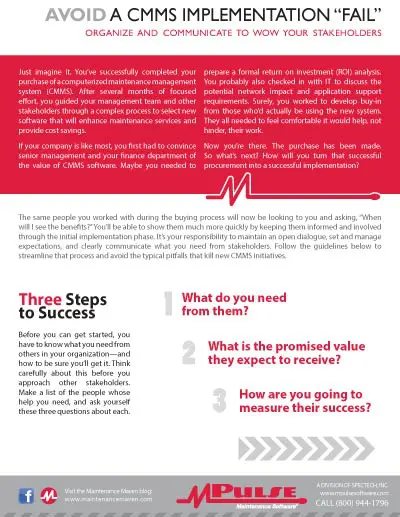Just imagine it. You’ve successfully completed your purchase of a computerized maintenance management system (CMMS). After several months of focused effort, you guided your management team and other stakeholders through a complex process to select new software that will enhance maintenance services and provide cost savings.
If your company is like most, you first had to convince senior management and your finance department of the value of CMMS software. Maybe you needed to prepare a formal return on investment (ROI) analysis. You probably also checked in with IT to discuss the potential network impact and application support requirements.
Surely, you worked to develop buy-in from those who’d actually be using the new system. They all needed to feel comfortable it would help, not hinder, their work.
Now you’re there. The purchase has been made. So what’s next? How will you turn that successful procurement into a successful implementation?
The same people you worked with during the buying process will now be looking to you and asking, “When will I see the benefits?” You’ll be able to show them much more quickly by keeping them informed and involved through the initial implementation phase.
It’s your responsibility to maintain an open dialogue, set and manage expectations, and clearly communicate what you need from stakeholders.
Follow the guidelines below to streamline that process and avoid the typical pitfalls that kill new CMMS initiatives.
Three Steps to Success
Before you can get started, you have to know what you need from others in your organization—and how to be sure you’ll get it. Think carefully about this before you approach other stakeholders.
Make a list of the people whose help you need, and ask yourself these three questions about each.
- What do you need from them?
- What is the promised value they expect to receive?
- How are you going to measure their success?
Step 1: Catalog Your Requirements
You can use a simple, multi-pass approach to organize and prioritize what’s needed from each department.
- List each department that must do something to support the CMMS implementation. Typical departments are IT, maintenance, operations, and finance.
- For each department, list the inputs they need to provide and the tasks they need to complete. For example, does IT need to increase network bandwidth? Do users in operations need to complete training? Will maintenance evaluate pilot runs of the system?
- For each departmental responsibility, indicate if it is required “Day 1”or if it can be scheduled for a subsequent phase of implementation. The quickest way to get bogged down is to think of your implementation as an “all or nothing” undertaking. Think “Day 1” and “what comes next” instead.
Step 2: Clearly Convey Pledged Value
Each department has already been promised something of value from the CMMS implementation.
Operations and production were promised better service at reduced cost from the maintenance team. Senior management and finance were promised a good return on investment. IT may have been promised an easy fit with their server and network infrastructure, and responsive vendor support.
Write out a short list of the anticipated benefits you’re trying to achieve for each of these departments, and (re)communicate them carefully and specifically to each. Also communicate specifically to each what you’ll need from them to achieve those goals.
Step 3: Set SMART Goals
Step 1 and Step 2 defined what you need and what you’re promising. Step 3 is about how you’ll measure it.
Use SMART criteria to help departments set implementation goals that are
- Specific
- Measurable
- Attainable
- Relevant, and
- Time-bound.
Being this specific will help set mutual expectations clearly and keep your implementation project on track, without disagreements about what was promised by who or when it was to be delivered.
Heroes Don’t Fail
Major system implementations are never easy. If you follow these three steps, though, you’ll help avoid some of the major “traps” that kill many promising projects. You’ll be your company’s CMMS implementation hero, and not just another implementation “fail.”








